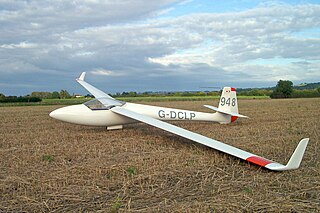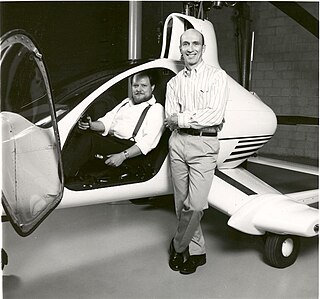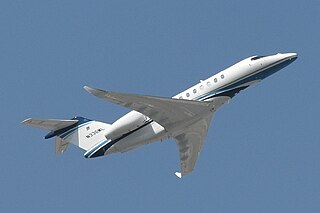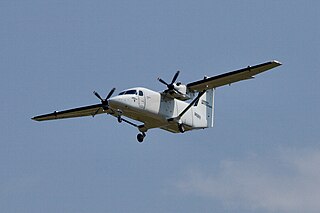
The fuselage is an aircraft's main body section. It holds crew, passengers, or cargo. In single-engine aircraft, it will usually contain an engine as well, although in some amphibious aircraft the single engine is mounted on a pylon attached to the fuselage, which in turn is used as a floating hull. The fuselage also serves to position the control and stabilization surfaces in specific relationships to lifting surfaces, which is required for aircraft stability and maneuverability.

The Mooney M20 is a family of piston-powered, four-seat, propeller-driven, general aviation aircraft, all featuring low wings and tricycle gear, manufactured by the Mooney International Corporation.

The Stinson 108 is a popular single-engine, four-seat, light general aviation aircraft produced by the Stinson division of the American airplane company Consolidated Vultee, from immediately after World War II to 1950. The 108 was developed from the prewar Model 10A Voyager.

The Cessna 400, marketed as the Cessna TTx, is a single-engine, fixed-gear, low-wing general aviation aircraft built from composite materials by Cessna Aircraft. The Cessna 400 was originally built by Columbia Aircraft as the Columbia 400 until December 2007. From 2013, the aircraft was built as the Cessna TTx Model T240.

The Eclipse 500 is a very light jet (VLJ) originally produced by Eclipse Aviation of Albuquerque, New Mexico, United States. The company was founded in 1998 to develop the 1997 Williams V-Jet II demonstrator. The prototype first flew with Williams EJ22 turbofans on August 26, 2002. The engines were replaced by Pratt & Whitney Canada PW610Fs in 2004 and Eclipse Aviation won the Collier Trophy in February 2006 for the design. A provisional FAA type certification was received on 27 July 2006 and the first delivery occurred on 31 December 2006.

The Glasflügel 201 Standard Libelle is an early composite Standard Class single-seat sailplane produced by Glasflügel from 1967.

The Cessna 421 Golden Eagle is an American six or seven seat twin-engined light transport aircraft, developed in the 1960s by Cessna as a pressurized version of the earlier Cessna 411.

The Berkut 360 is a tandem-seating, two-seat homebuilt canard aircraft with pusher configuration and retractable landing gear, built primarily of carbon fiber and fiberglass.

The Cessna 162 Skycatcher is an American side-by-side two-seat, high-wing, strut-braced, tricycle gear light-sport aircraft (LSA) that was designed and produced by Cessna between December 2009 and December 2013. Its intended market was flight training and personal use.

The Glasflügel H-301 Libelle is an early composite single-seat sailplane produced by Glasflügel from 1964 to 1969. The H-301 had camber-changing wing flaps so was required to compete in the Open Class because the Standard Class excluded wing flaps. It was often known as the Open Class Libelle.

The Champion 402 Lancer is a twin-engine trainer produced by Champion Aircraft, a high-wing monoplane based on the tricycle gear Champion 7FC Tri-Traveler, but with wing-mounted Continental O-200-A engines. The Lancer first flew in 1961 and production began in 1963. The Lancer seats two in a tandem configuration with dual flight controls; the pilot in command or student pilot normally occupies the front seat.
The Eagle AC-7 Eagle 1 is an aircraft that was manufactured by Windecker Industries. It was the first composite airplane to receive FAA certification in December 1969 at a reported development cost of US$20,000,000. The fiberglass process was named "Fibaloy" by Windecker.

The Schweizer SGS 1-34 is a United States Standard Class, single-seat, high-wing glider built by Schweizer Aircraft of Elmira, New York.

The Schweizer SGS 1-35 is a United States 15 Meter Class, single-seat, mid-wing glider built by Schweizer Aircraft of Elmira, New York.

The Prescott Pusher is an American, four-seat, pusher configuration homebuilt aircraft, with a large cockpit, retractable or fixed gear, and a T-tail. The pilot and passengers enter the aircraft through a large left-side clamshell door.

The FFA Diamant is a family of Swiss high-wing, T-tailed, single-seat, FAI Standard Class and FAI Open Class gliders that was designed by engineering students under supervision of Professor Rauscher at the ETH Zurich and manufactured by Flug- und Fahrzeugwerke Altenrhein AG (FFA) of Altenrhein, Switzerland.

The Glasflügel 205 Club Libelle is a high wing, T-tailed, single seat glider that was designed and produced in West Germany by Glasflügel for club and rental use.

Skyworks Aeronautics Corp., formerly Groen Brothers Aviation, Inc., Groen Aeronautics Corporation and Skyworks Global, is an American autogyro research and development company based in Chicago. The company was founded in 1986 by David Groen and his late brother Jay Groen in Salt Lake City, Utah. David Groen remains as Senior Advisor.

The Cessna Citation Longitude is a business jet produced by Cessna, part of the Cessna Citation family. It remains the largest business jet by Cessna. Announced at the May 2012 EBACE, the Model 700 made its first flight on October 8, 2016, with certification obtained in September 2019. The aluminum airframe has the fuselage cross-section of the Citation Latitude, stretched by a seat row. Powered by Honeywell HTF7000 turbofans, it has a new ~28° swept wing and a T-tail for a 3,500 nmi (6,500 km) range.

The Cessna 408 SkyCourier is an American utility aircraft designed and built by the Cessna division of Textron Aviation. It was launched on November 28, 2017, with an order for 50 from FedEx Express, with the aircraft designed for the needs of its FedEx Feeder service. It made its first flight on May 17, 2020, and was type certified on March 11, 2022. FedEx took delivery of the first production model on May 9, 2022.


















